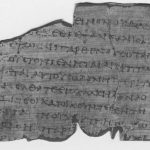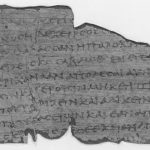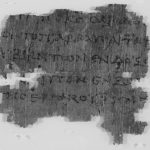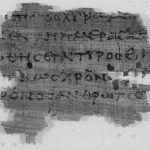| Artefact ID | 519 |
| TM ID | TM 61964 |
| Findspot (DEChriM ID) | - () | Class | Textual |
| Material | Papyrus |
| Writing medium | Codex |
| Text content | Literary |
| Language | Greek |
| Description | BASP 47 (2010): 33-43; AT130; Aland AT130 A papyrus folio containing Isaiah 23:4-15 (Oracle against Tyre). The edition unifies a previously published fragment (Library of Congress inv. 4082B, containing Isa 23:4-7 and 10-13) with the fragments in Princeton (H.I. Bell inv. II 2G, containing Isa 23:8-10 and 14-15). The larger LoC-fragment measures 12.4 x 6.7 cm (10 lines of text on both recto and verso, preserving the side margins as well as 0.6 cm of a top margin), while the HIB-fragment measures 5.0 x 5.7 cm (5 lines of text on both recto and verso, preserving a lower margin of 1.5 cm). Together they comprise the bottom (HIB) and the top (LoC) of a folio, with a middle part of the page missing. The ed. pr. estimates a loss of 3-4 lines of text between the two fragments. The script is described as an informal round hand, relatively upright and written quickly, with a particularly impactful beta (e.g. in l. 14 verso, where the bottom stroke extends under 5 letters) that resembles the beta in P.Chester Beatty V (Book of Genesis; 3rd c. Aphroditopolis); see ed. pr. Deletion is marked by dots, and there are no further lectional aides or punctuation: there appears to be one apostrophe after "Sabaoth", and the number “seventy” in written out in full (see l. 17-18 recto; the ed.pr. mentions that this is a trait in Jewish compositions). There is furthermore only one nomen sacrum (for κυριός in l. 19 recto), whereas words that are usually contracted (e.g. ἄνθρωπος) remain written out in their full form. |
| Selection criteria | Literary genre (Biblical) |
| Date from | 275 |
| Date to | 325 |
| Dating criteria | Palaeography. The editor of the LoC-fragment places the hand in the end of the 3rd c. and gives a comparandum of P.Ryl. III 489 (Lysias, 3/4 c., Oxyrhynchus); see Donovan 1968: 625-629. The ed.pr. adds P.Oxy. LXIX 4705 (Shepherd of Hermas, first half of the 3rd c., Oxyrhynchus) to the comparanda, giving the date of 3rd or early 4th c. |
| Absolute/relative date | Relative date |
| Archaeological context | Provenance is unknown. The Princeton-fragment was acquired by Robert Garrett in 1924 and donated it to the University of Princeton in 1942; the Library of Congress-fragment was donated by Seymour de Ricci in 1931; see ed. pr. |
| Accession number | Princeton, University Library Garrett deposit 1924, H.I. Bell II 2G, as well as in Washington, Library of Congress Manuscript Division, inv. 4082 b [Isaias]. |


 Json data
Json data







